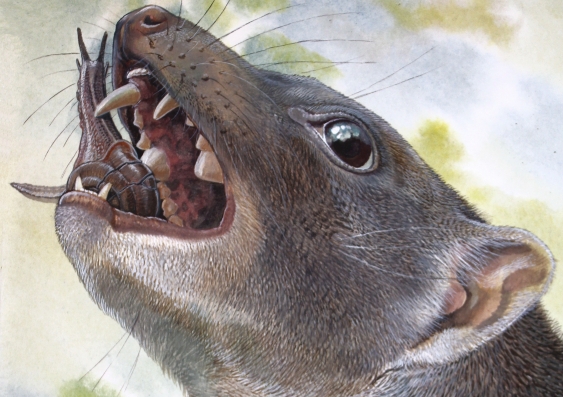Yet more weird ancient marsupials rewrite the history books
2025-08-20T09:00:00+10:00

Fossil specimens of "hammer toothed" carnivorous marsupials found at Riversleigh in northern Queensland.
║┌┴¤═°┤¾╩┬╝Ã/Grace Gadsby
║┌┴¤═°┤¾╩┬╝à researchers are learning that ancient Australia was home to far more carnivorous marsupials than once thought.
A team of ║┌┴¤═°┤¾╩┬╝à scientists has found fossil remains of three carnivorous marsupials which lived millions of years ago and were previously unknown to science.
Marsupials have called Australia home ever since they wandered over from South America via Antarctica around 55 million years ago.
That was back before the supercontinent Gondwana had fully broken up and the map of the world looked a bit different.
Antarctica wasnÔÇÖt where it is now and sported a lush, temperate rainforest rather than the frozen wasteland we know today.
Once the Antarctic land bridge disappeared, it stranded the ancestors of modern Australian marsupials here.
And theyÔÇÖve thrived.
ÔÇ£Starting from whatÔÇÖs believed to be a small group of ancestors, thereÔÇÖs been an explosion of marsupial life in Australia over the last 55 million years,ÔÇØ says study lead author Dr Timothy Churchill.
ÔÇ£Hundreds and hundreds of species, many now extinct, evolving to fill a galaxy of ecological niches.ÔÇØ┬á
Three new marsupial ancestors
Around 25 million years ago whatÔÇÖs now northern Australia was transitioning from the Late Oligocene Period into the early Miocene.
Instead of the arid grasslands youÔÇÖll find in the region today, the area had become relatively warm and humid, supporting what may have been open as well as areas of closed forest.
It was in this environment that the three new extinct carnivorous marsupialsÔÇöÔÇömade their home.
These ÔÇ£malleodectidsÔÇØ (literally "hammer teeth") as theyÔÇÖre known, evolved big, hammer-shaped rear premolars to smash the hard shells of snails to eat their soft flesh.
The work builds on previous ║┌┴¤═°┤¾╩┬╝à analyses which found yet more hammer toothed marsupials in the same areaÔÇöten million years after this group roamed the area around Riversleigh in northern Queensland.
It shows that this subset of snail-loving marsupials was much more diverse and existed millions of years earlier than previously assumed. 
The fossilised teeth Dr Churchill has analysed also give a sense of how these creatures evolved and suggest that the snail-eating specialisation developed slowly, over millions of years.
Their diet changed gradually, as did their teeth, perhaps alongside an increase in the availability and diversity of some kinds of hard-bodied prey, like snails, as the climate got warmer, wetter, and the forests got lusher.
ÔÇ£Malleodectids werenÔÇÖt just a short-lived branch that appeared when AustraliaÔÇÖs environment was at its lushest,ÔÇØ says Dr Churchill.
ÔÇ£Instead, they were a┬álong-surviving lineage┬áthat occupied a variety of carnivorous niches for at least 15 million yearsÔÇöincluding some specialised roles no longer practiced by Australian marsupials today, such as snail-eating.ÔÇØ
Every time I open a specimen drawer, another enigmatic species seems to come to lifeÔÇöand itÔÇÖs becoming clear weÔÇÖve only just begun to uncover this hidden diversity.
A diverse family tree
Dr Churchill has found that the three new carnivorous marsupials were between 110-250 grams, similar in size to the modern sugar glider.
These animals shared the forest with a broad range of other marsupials of various sizes that inhabited a wide range of ecological niches.
These include medium-sized marsupials similar to the now extinct Tasmanian tiger (or ÔÇ£thylacineÔÇØ), smaller predators around the size of modern quolls, and even marsupial lions ranging from cat to leopard sized.
ÔÇ£The picture emerging is overturning old ideas that Australia was dominated by 'simple' marsupials while reptiles ruled the ecosystem,ÔÇØ Dr Churchill says.
But the story of how marsupials evolved into what we see today isnÔÇÖt complete.
Researchers are still trying to work out, for example, what filled the niche that the smallest carnivorous marsupials fill todayÔÇöthings like dunnarts and planigales.
ÔÇ£Every time I open a specimen drawer, another enigmatic species seems to come to life ÔÇö and itÔÇÖs becoming clear weÔÇÖve only just begun to uncover this hidden diversity.ÔÇØ
Media enquiries
Tom Melville, ║┌┴¤═°┤¾╩┬╝à Science
Tel: +61 432 912 060
Email: tom.melville@unsw.edu.au




